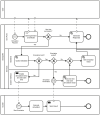Data Ecosystems for Scientific Experiments: Managing Combustion Experiments and Simulation Analyses in Chemical Engineering
- PMID: 34604739
- PMCID: PMC8479200
- DOI: 10.3389/fdata.2021.663410
Data Ecosystems for Scientific Experiments: Managing Combustion Experiments and Simulation Analyses in Chemical Engineering
Abstract
The development of scientific predictive models has been of great interest over the decades. A scientific model is capable of forecasting domain outcomes without the necessity of performing expensive experiments. In particular, in combustion kinetics, the model can help improving the combustion facilities and the fuel efficiency reducing the pollutants. At the same time, the amount of available scientific data has increased and helped speeding up the continuous cycle of model improvement and validation. This has also opened new opportunities for leveraging a large amount of data to support knowledge extraction. However, experiments are affected by several data quality problems since they are a collection of information over several decades of research, each characterized by different representation formats and reasons of uncertainty. In this context, it is necessary to develop an automatic data ecosystem capable of integrating heterogeneous information sources while maintaining a quality repository. We present an innovative approach to data quality management from the chemical engineering domain, based on an available prototype of a scientific framework, SciExpeM, which has been significantly extended. We identified a new methodology from the model development research process that systematically extracts knowledge from the experimental data and the predictive model. In the paper, we show how our general framework could support the model development process, and save precious research time also in other experimental domains with similar characteristics, i.e., managing numerical data from experiments.
Keywords: combustion kinetics; data management; data quality; data validation; experiments management; scientific experiments; scientific model development; simulation analysis.
Copyright © 2021 Ramalli, Scalia, Pernici, Stagni, Cuoci and Faravelli.
Conflict of interest statement
GS is an employee of Roche. The remaining authors declare that the research was conducted in the absence of any commercial or financial relationships that could be construed as a potential conflict of interest. The handling editor declared a past co-authorship with one of the authors BP.
Figures










References
-
- Alshuqayran N., Ali N., Evans R. (2016). “A Systematic Mapping Study in Microservice Architecture,” in 2016 IEEE 9th International Conference on Service-Oriented Computing and Applications (SOCA), Macau, China, November 4–6, 2016. 44–51. 10.1109/soca.2016.15 - DOI
-
- Batini C., Scannapieco M. (2016). Data And Information Quality - Dimensions, Principles And Techniques. Data-Centric Systems and Applications. New York: Springer.
-
- Bernardi M. S., Pelucchi M., Stagni A., Sangalli L. M., Cuoci A., Frassoldati A., et al. (2016). Curve Matching, a Generalized Framework for Models/experiments Comparison: An Application to N-Heptane Combustion Kinetic Mechanisms. Combust. Flame 168, 186–203. 10.1016/j.combustflame.2016.03.019 - DOI
-
- Brázdil R., Pfister C., Wanner H., Von Storch H., Luterbacher J. (2005). Historical Climatology in Europe–The State of the Art. Clim. Change 70, 363–430. 10.1007/s10584-005-5924-1 - DOI
LinkOut - more resources
Full Text Sources

